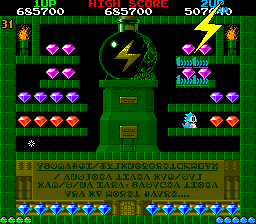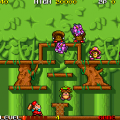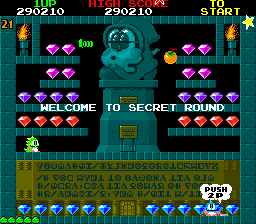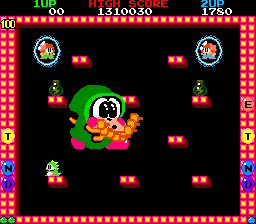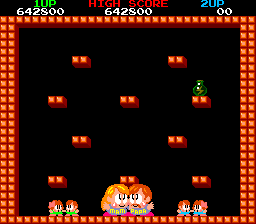If you were to enter an arcade in the early-to-mid 1980s you would be greeted by a host of near-legendary titles – Pac-Man, Frogger, Mario Bros., Donkey Kong, and BurgerTime. You would also see a rather unassuming title starring a pair of green and blue dragons running about a maze shooting bubbles at cute monsters. At first glance, this game wouldn’t seem like much, but if you were to spend enough time playing it you would soon realize this cutesy game was deceptively complex. Filled with bizarre rules, secrets that gave way to more secrets, and complicated level designs Bubble Bobble would make an impression that would eventually lead it to become one of the most memorable arcade games ever known.
Bubble Bobble seems simple enough when you start your first game. Two cute dinosaurs bounce around simple stages blowing bubbles at little monsters that, when popped, turn into tasty food items. And it is simple and cute – at the very beginning. Once you take a harder look at the game – at how the stages are actually designed, how the power-up items actually spawn, how you reach the secret rooms with sinister music and cryptic encoded messages, along with the punishing ending, Bubble Bobble is nowhere as simple as it seems.
Bubble Bobble is the creation of Fukio Mitsuji, who had previously worked on Super Dead Heat, Land Sea Air Squad, and Hailey’s Comet. Mitsuji sought to focus his combined experiences from those previous titles and create a new arcade game that was not only fun, but also was based on cooperation between two players. At the same time, Mitsuji remembered that before Bubble Bobble was released most arcade patrons in Japan at the time where men, so he wanted to create a game that appealed to women and couples as well.
The result of Mitsuji’s efforts was Bubble Bobble. In it, brothers Bubby and Bobby search for their girlfriends Betty and Patty after they enter the Cave of Monsters and are captured by Super Drunk, the ruler of the cave. The brothers are also transformed into bubble dragons upon stumbling across Super Drunk themselves, and are then tasked with descending through all 100 levels of the Cave of Monsters to save their girlfriends and return to their original forms.
Despite the story, most people likely fed the arcade machine some money after seeing the bright colors and simple gameplay during the game’s demo and found it to be fun and addicting. Bubble Bobble’s music is catchy and upbeat, and its graphics are bright, cheerful, and charming. Bub and Bob waggle their arm fins when shooting bubbles, squish up against walls when their bubbles are too large for the passage they’re firing into, collapse to the ground with stars circling their heads when they get hit, and are reduced to comical piles of ash when struck by fire or lasers. It’s an intentionally adorable game meant to appeal to couples wanting to play a game together.
Bubble Bobble‘s central mechanics are also easy to grasp – Bub and Bob blow bubbles which can trap monsters and, when either dragon touches the bubbles with their arm fins or the spines on their backs, pop them to defeat whatever monsters have been trapped inside. Popped monsters transform into food items that provide precious bonus points and extra lives are provided at certain point totals, though they can also gain additional lives by collecting letter bubbles to spell “EXTEND”. If either brother is touched by one of the monsters, they are defeated instantly and lose a life. Finally, special power-ups appear throughout the stage, granting Bub and Bob greater firing speed or range, producing high-value point items, or filling the stage with deadly projectiles that defeat enemies on hit.
Players can use these techniques to quickly push through the early part of the game, however around floor 25 the game reveals itself for what it truly is – a brutal, complicated quarter muncher with a very nasty surprise at the end for single players or inadequately skilled couples.
As the game progresses, players need to learn more advanced techniques and obtuse rules if they hope to ever reach the end. At first, bubbles the brothers fire travel a short distance and then hover upward as one would expect a bubble to do. Later on invisible currents catch those bubbles and move them about the stage on certain paths. Players can bounce on bubbles by holding down the jump button, enabling them to travel around these pathways and reach monsters they wouldn’t be able to by jumping normally.
Additionally, monsters gradually become more powerful and can break out of bubbles much faster than normal. In fact, in the final stretch of the game certain stages enable monsters to break free after only being imprisoned for a second or less. This becomes a huge problem, as escaped monsters become enraged and move much faster and more erratically, making them harder to hit and more likely to shave down the players’ life totals. Stages like these require a special technique known as “kissing” – so named for the way it looks like Bub or Bob kiss the monster. Firing a bubble just an instant before a monster touches Bub or Bob traps them and then immediately pops the bubble, defeating the monster in an instant. This is incredibly important, as popping bubbles normally often takes too long in later stages as it is either too difficult to hit the bubble with the bubble dragons’ spines, or to push on them long enough for their flippers to finally burst them. Worse still, currents on later stages grab bubbles and shove them upward too quickly for the brothers to pop. On top of all of this an invisible timer runs during each stage and, if players take too long, invincible Skel Monstas appear and chase after Bub and Bob.
Further complicating matters is the environment itself. Passages become difficult to navigate, requiring players to use special bubbles that float around stages that contain lightning, fire, and water. Early on these are fun diversions – fire drops a patch of flame that spreads across the floor, slowing Bub and Bob down as they try to work their way through it while defeating any monsters that get caught or wander into the patch. Lightning fires a bolt that briefly paralyzes whichever brother is struck by it, while also cutting through walls and blowing away any monsters it comes in contact with. Water quickly travels along the floors and washes down narrow holes, dragging the brothers with and enabling them to pass through too-small passages while also knocking out any monsters who get caught in the current. Monsters defeated using any of these methods drop gemstones that are worth huge amounts of points, granting extra lives early on.
Though fun to experiment with at first, the game’s harsh difficulty ramps up and requires players to use these bubbles to “solve” puzzles on later floors. Players can try to brute force their way through these stages using simple bubble jumping and bursting techniques, though they’ll frequently be punished by the harsh placement of multiple monsters and short bubble-capture timers. On top of that, some monsters become unreachable by normal means, and only careful use of these bubbles will enable players to move on to the next floor. Worse still, many special bubbles won’t appear where they are needed unless players carefully nudge them into locations and currents without popping them.
Players also must quickly realize that lightning, fire, and water bubble attack paths aren’t random – it’s based entirely on how the bubble is popped. Popping a lightning bubble while facing right, for example, causes the bolt to travel left and vice versa. The same is true of fire – popping the bubble while facing left left causes the patch to travel right. Water follows the same rule, which is critical to draining through the proper pathways on certain stages.
In fact, very little is actually random in Bubble Bobble. Every monster has its own travel pattern, every bubble follows a predetermined path depending on the current blowing through each stage, and extra life letter bubbles appear based on certain actions and stage conditions. Even the power-ups that appear on each stage are based on a complicated series of variables – which the players themselves are responsible for.
Bubble Bobble tracks the actions of every player that joins the game from the moment it is powered on. The distance players move along the ground, the number of bubbles hopped upon and burst, the types of power-ups collected – all of it is logged. Once a certain threshold is reached, a particular item spawns on the next floor. Blowing 35 bubbles, for example, cues the game to spawn a pink and white range-increasing candy, while popping 15 water bubbles creates an umbrella item that enables players to skip 3 levels when collected. Items are even spawned based on the number of times player 1 or player 2 joined the game, the number of times players failed to complete a stage before Skel Monstas appeared, and even the total number of stages completed while the arcade machine was first powered on. Not only that, the players’ score counter can transform any empty bubbles floating around the stage into point items. If the final enemy of the stage is defeated when both players have identical 10s and 100s digits, for instance, all empty bubbles with transform into certain food items depending on the digits matched.
This is frequently the reason why different players have different power-up experiences, with powerful items appearing as early as stage one. The internal counter is reset once the machine is turned off, however, resulting in the next day’s power-up encounters being very different from the previous days. It’s an exhaustive system that most people will likely play without thinking about, but those that do can manipulate it to achieve high scores and collect critical items to push through – or entirely skip – difficult levels.
With all that in mind, Bubble Bobble is designed to be a cooperative experience. While single players can make it through early stages easily enough, later stages are much easier with two players. More difficult stages are absolutely swamped with monsters, with many buzzing around in strange patterns created by the environment while others fire dangerous projectiles. A fully powered up Bub or Bob can make short work of most of these monsters, but losing a life strips them of all that power, leaving them rather slow with limited range. A second player can make the load much easier to bear as both coordinate how they trap and pop monsters while eliminating them before they become serious threats.
Playing with two players also makes it easier to continue. If one player loses his or her last life, they can quickly feed the machine more money and then immediately respawn back into the stage. If both players have lost all their lives, the game instantly ends – all that hard work and money is gone. This is true of the single player experience; without a second player around the game is under constant threat of ending immediately once the last life is gone, making cooperative play almost a necessity to reach the ending – unless you know about the unadvertised method of holding down start just as you are about to game over while you still have credits left. Doing so enables a single player to continue playing on the same stage, but it only adds to the stress of making sure you have both enough money to continue pushing through and ensuring you always have credits available. Even continuing while single is cryptic in Bubble Bobble.
Once you beat the game, it’s not over – finishing with your partner reveals you achieved a good ending, but not the “best” one and you’re provided with a code to input into the machine to play Super Mode, which features arranged stages and stronger enemies that appear at the beginning of the game. While it’s similar to an expert mode, later stages actually prove to be somewhat easier than their counterparts in normal mode.
If you beat the game as a single player, or if your partner was defeated and didn’t continue before you beat the final boss, then too bad. The game plays some grim-sounding music for you, talks about how you failed your quest since you didn’t have a partner, and then shunts you back to stage 80. Your only option at that point is to climb back down to level 100 and then start shouting for help from someone on the arcade floor to join you, feed one last credit into the machine while the final boss is trapped in a bubble to bring a zombie player 2 in, or make sure your partner doesn’t kick it before you beat the boss again. That, or you can walk away muttering some choice feedback.
The worst part about the bad ending is that it isn’t telegraphed until you either stumble upon it honestly or you’re an extraordinary Bubble Bobble player. Reaching level 20 without dying once spawns a hidden door that, when entered, gives you a ton of point gems and a strange series of symbols written on the background of the stage. The symbols aren’t just random garbage – they’re actually the Rosetta stone of the game’s unique language. Reaching level 30 without dying reveals another secret room with more gems and a message to be decoded, which hints at needing a second player to reach the good ending. Managing to fight through to floor 40 without ever dying reveals a secret room with a final message, this time hinting about how to defeat the final boss. If you’re so skilled to can make it to level 50 without ever being touched by the monsters, you are rewarded with a door that punts you 20 levels ahead to floor 70 – at which point you can resume dying as there’s no further bonus for being perfect.
Of course, you’ll need to have the wisdom, foresight and patience to ever achieve these feats. Also, if you were playing this back when it was first released you would need to have a pen and paper handy to write down all the symbols – or have a Polaroid camera handy to make a crude screenshot. You’d also have to do this quickly as, like every other stage in the game, the hidden floors are on a timer. Taking too long spawns a bizarre pickle-like creature known as a Rascal (or a Rubblen in the US version) that wants Bub and Bob dead as much as any of the other monsters they’ve encountered. Chances are most players will simply reach the final stage and be disappointed, rather than go through all those complications. Still, it’s yet another layer of mystery on a seemingly cute, innocent experience.
Bubble Bobble is an excellent game, and its co-op feature makes it all the better. The game is not without its faults, though. From the moment you join the game until the moment you finish you’ll hear the exact same song, save for the rare times you find the hidden stages or collect an extra life from the letter bubbles. While it’s chipper and catchy for the first few plays, it becomes fairly grating by the time you reach the midpoint of the game – especially if you’ve been dying frequently. The difficulty is prone to violent swings, starting off fairly easily and quickly become hard to the point of being unfair. Some stages will even start with enemies hovering above you before dropping them onto your head, requiring that you’re dialed-in at all times.
Perhaps worst of all is the level design on certain stages. While it’s understandable to expect players to learn about bubble jumping, walls are frequently placed extremely tightly. Some stages feature tight-walled pits that require a pixel perfect jump, followed by a perfect bubble, and ending with an immediate jump. Failure to pull this off properly will result in the bubble instantly bursting, leaving Bub and Bob vulnerable to enemies. It can be rather tough to do, and frequently players will find themselves unable to jump out of a pit and left to the mercy of invincible Skel Monstas. Worse still, certain levels feature walled pits that are too tight to bubble jump out of, leaving them to flail around in hopes of accidentally clipping through the floor or waiting for their inevitable deaths. This is clearly a design choice as it’s replicated throughout Bubble Bobble’s numerous ports, save for the NES version which mercifully widens most of these pits. It stands as a testament that while Fukio Mitsuji wanted to create a fun game for couples, it still needed to make money to keep the lights on.
Bubble Bobble was a success at the arcade, and has received various honors by gaming publications and websites while appearing on various “best of” lists. It was later ported to over 20 different platforms, though the quality of these ports varies greatly depending upon the system they appeared on.





